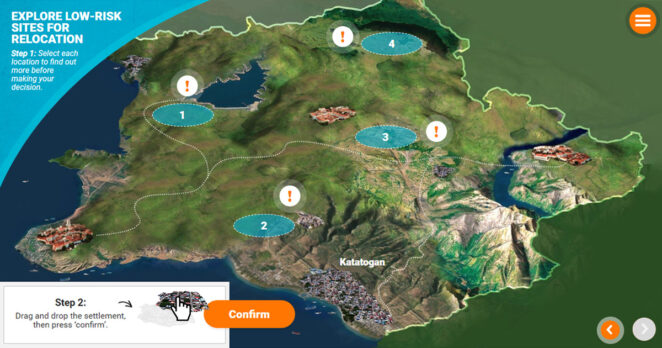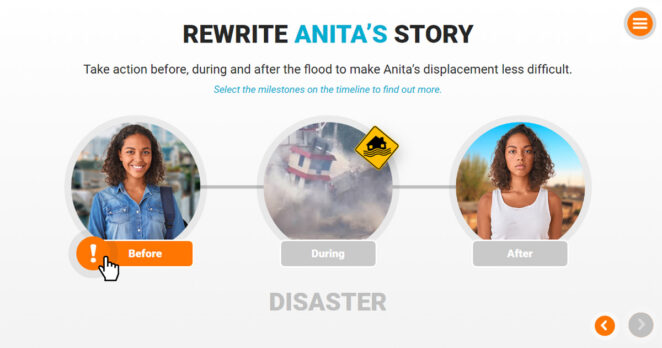e-Learning course: Disaster Displacement

- Level: Introductory
- Time commitment: 40-50 minutes per module (5 modules in total)
- Learning product: online course
- Sector: disaster risk management and reduction
- Language:English and Spanish (French to be added soon)
- Certificate available: yes
Introduction
Forced displacement is one of the most common and immediate impacts of disasters. Facilitating people’s movement to avoid their exposure to life-threatening situations via evacuations or planned relocations is one of the most effective ways of reducing mortality and injury. Having to flee one’s home, however, particularly when return is not possible for an extended period, tends to increase humanitarian needs and expose people to other significant risks linked to their displacement.
The eLearning course offers practical guidance to help governments and regional organizations integrate disaster displacement into their DRR strategies, policies and laws, in accordance with the Sendai Framework for Disaster Risk Reduction 2015-2030. The Sendai Framework recognizes disaster displacement – the forced or involuntary movement of people associated with disasters – as an important concern. Target (E) of the Sendai Framework sets out to ‘Substantially increase the number of countries with national and local disaster risk reduction strategies by 2020’.
This interactive and dynamic eLearning course distils the guidance of the Words into Action GuidelineDisaster Displacement: How to Reduce Risk, Address Impacts and Strengthen Resilience.The Words into Action tools support States to meet this target by providing DRR policy makers and practitioners with knowledge to prevent, prepare for and respond to disaster displacement.
To gain access to the Disaster Displacement e-learning course enrollhere.
Institutional background
This eLearning course was developed through a partnership between the Norwegian Refugee Council, the Platform on Disaster Displacement and the United Nations Office for Disaster Risk Reduction through the support of the German Federal Foreign Office.
Who would find this useful?
The course is intended for disaster risk reduction professionals: both practitioners and policy makers. Others working on sustainable development, climate change adaptation and poverty eradication would also benefit.
Training material
Introduction
This section explores:
- The importance of addressing disaster displacement.
- What to expect from the e-learning course.
Module 1. Prevent Disaster Displacement and Strengthen Resilience
This section explores:
- How to prevent disaster displacement by understanding the underlying risk drivers that can lead to displacement.
- How to effectively address displacement risk within laws, policies and governance mechanisms.
- The integration of displacement data in risk assessment.
- Amending or creating relevant laws and policies.
- Cross-sector and government-wide involvement and coordination and more.
Module 2. Prepare for Disaster Displacement
This section explores:
- The need to meaningfully inform and consult previously displaced and at-risk communities.
- How to plan for the short and long-term needs of displaced people.
- The effective implementation of early warning and preparedness programmes to reduce displacement risk and more.

Module 3. Respond to Disaster Displacement
This section explores:
- The need to identify and address the specific assistance and protection needs of disaster displaced people.
- How to meet minimum humanitarian principles and standards in disaster displacement contexts, including on response coordination and more.
Module 4. Support Resilience and find durable solutions
This section explores:
- The need for adequate budgetary allocations and authority to assist displaced people and host communities.
- The alignment and close coordination of rehabilitation and development programming with emergency assistance.
- The long-term need for access to services and livelihood opportunities.
- The continual assessment of displacement risk and resilience and more.
Module 5. Actions and their impacts
This section explores the topics discussed in previous modules through an interactive exercise to consolidate the users knowledge, awareness and understanding alongside a Final Quiz. Each user will receive a completion certificate upon completion of the e-learning course.

Learning outcomes
On completion of this course you will know:
- How to prevent disaster displacement by understandingthe underlying risk drivers that can lead to displacement;
- How to effectively address displacement risk within laws, policies and governance mechanisms;
- How to prepare for disaster displacement;
- The need to identify and address the specific assistance and protection needs of disaster displaced people;
- How to meet minimum humanitarian principles and standards in disaster displacement contexts, including on response coordination;
- How to support resilience and find durable solutions for people who are displaced or at risk of disaster displacement and their host communities.
Watch this online presentation and Q&A for more information on the learning outcomes:
Related resources
- e-Learning course: Disaster Displacement
- Addressing Disaster Displacement in Disaster Risk Reduction Policy and Practice: A Checklist
- Words into Action Guideline Disaster Displacement: How to Reduce Risk, Address Impacts and Strengthen Resilience
- Prepare Children to Deal with Disaster and Climate Impacts
- Transforming Development and Disaster Risk
- Guardians of the Planet: Asia Pacific Children and Youth Voices on Climate Crisis and Disaster Risk Reduction
(0) Comments
There is no content